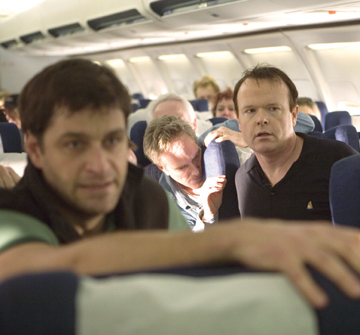 The passengers of ‘United 93,’ including Daniel Sauli (left) and Christian Clemenson (right), prepare to take action against the hijackers.
The passengers of ‘United 93,’ including Daniel Sauli (left) and Christian Clemenson (right), prepare to take action against the hijackers.
|
| United 93\r\nWritten and directed by Paul Greengrass. Rated R. |
|
A D V E R T I S E M E N T
|
|
|
|
A D V E R T I S E M E N T
|
|
We Could Be Heroes
The passengers of United 93 receive a fitting tribute in this unnerving film.
By KRISTIAN LIN
I keep thinking about a line of dialogue from a 1992 movie called Hero about a small-time criminal who saves a plane filled with people. The line is, “We’re all heroes if you catch us at the right moment.” Real-life heroes don’t tend to be square-jawed men and beautiful women with unflappable demeanors and muscled bodies. They tend to be ordinary-looking, and though they occasionally have jobs that lend themselves to heroism, like police work, firefighting, or emergency medical assistance, more often they’re office managers or librarians or janitors who are thrust into extreme circumstances and react appropriately.
The passengers on United Airlines Flight 93 on Sept. 11, 2001, were such people. They acted as they did not because they were innately more virtuous than everybody else, but because their circumstances made it possible. Unlike those on the other hijacked flights, 93’s flyers were informed of the bad guys’ true intentions. Had the attack taken place before cell phones and CNN, they probably would have kept their seats while the terrorists carried out their mission. That doesn’t diminish the fact that they did what no one on the ground that day was in a position to do, which was stop the hijackers. The U.S. Capitol stands today almost certainly because of them.
A movie was inevitably going to be made, so it’s good that the first filmmaker to do it is Paul Greengrass. He directed The Bourne Supremacy two years ago, but before that he made a more relevant work in his native United Kingdom called Bloody Sunday, which was also about a national calamity (Northern Ireland’s), re-creating historical events in scrupulous, carefully researched detail and a realistic style, with grainy film stock and handheld cameras. He brings this same regard for verisimilitude to United 93, depicting the events at hand from the point of view of a bystander happening on the scene.
Much like the 9/11 Commission Report did, the movie strips the story down to its skeleton, leaving little room for sentimentality and no room for politics (though when the military officials try to contact President Bush, it’s hard not to remember that the commander-in-chief is in a school in Sarasota at that moment reading about a pet goat — thank you, Michael Moore). The narrative shifts between the doomed flight, a NORAD control center in upstate New York, and various air traffic control centers in New York, Cleveland, and Herndon, Va., as military and civilian personnel try to figure out what is going on and how to respond to unprecedented events as they happen. Conventional characterization would strike a fatally false note in this context, so all we learn about the people we’re watching is what we pick up from stray, overheard bits of conversation, co-pilot LeRoy Homer Jr. (Gary Commock) mentioning his kids or passenger Mark Bingham (Cheyenne Jackson) discussing his passion for rugby. The unknown actors here are indistinguishable from the nonprofessionals — real-life military and air traffic officials who were on duty on Sept. 11 portray themselves, while the crew of United 93 is played by actual United Airlines crew members.
This is probably the only approach that audiences would find remotely palatable right now. How else are you going to do it, with expensive sets and A-list movie stars who are perfectly made up and backlit? Do you want that movie? I know I don’t. We’ll probably get it anyway at some point, perhaps in a few months if Oliver Stone’s World Trade Center is what I’m afraid it will be. The important thing is that United 93 never feels exploitative, though some of it is difficult to watch. Whereas the sequences on the ground have their share of Hollywood-like thrills (such as when the air traffic controllers frantically try to keep a Delta plane from colliding with one of the hijacked American Airlines flights), the ones on the airplane achieve something rawer and purer, a sweaty claustrophobic vertigo that’s probably somewhat like the terror and the feeling of being trapped that the passengers on United 93 must have felt. The immediacy of this experience is created by the realism of Greengrass’ filmmaking. It isn’t pleasant at all, but if it were, that would be obscene.
Most people think of movies as entertainment. Some people think of them as art. There isn’t a whole lot of artistry in United 93. As for entertainment, it won’t fit most people’s idea of a good time. But there’s another purpose for movies, one that this film serves. Movies are a substitute for bad experiences that real life occasionally serves up, ones that you’d never seek out. They can show you what it’s like to see your own death unfolding before you, and what it means to overcome paralyzing fear and do what needs to be done. Then the lights go up, and you’re released back into the world physically unscathed, wiser and better (one hopes) for having lived someone else’s misfortune for a couple of hours. Perhaps you’re still not ready to revisit the events of 9/11 in this way; for sure, not everyone will be. If you are, though, watching this re-creation seems as good a method as any to honor those unremarkable passengers on Flight 93 and their remarkable final act.
 Email this Article...
Email this Article...

